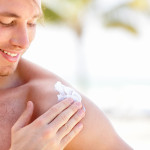
Most of us enjoy the warm rays of the sun. The sun feels nice on our skin and helps our bodies make vitamin D, which is important for calcium absorption and healthy bones. Yet sun exposure can be harmful to our skin and may lead to wrinkles and skin cancer. Sunburn can happen quickly (within 15 minutes), and skin damage can occur even before your skin turns red. In fact, specialists admit that just one blistering sunburn can double a person’s risk for developing melanoma, a severe type of skin cancer. So, the best way to get enough vitamin D is to take a daily supplement or daily vitamin.
Who is at risk for serious sun damage and skin cancer?
Anyone who spends time in the sun, especially without sunscreen, is at risk of having serious damage to their skin, which includes skin cancer. In fact, the EPA (Environmental Protection Agency) reports that 1 in five Americans will develop skin cancer in their lifetime. Children are particularly at risk for too much sun exposure.
Some people are at a higher risk due to the following:
- Fair skin, light colored eyes, blonde or red hair
- Multiple moles: typically twenty five or more
- Exposure to UV rays from the sun or indoor tanning beds
- A history of frequent or severe sunburns
- A family history of melanoma (a type of skin cancer) or other skin cancers
- Certain medicines (such as doxycycline) can cause the skin to burn more easily
What are UVA/UVB rays?
UVA and UVB rays are types of sunlight that can cause the skin to tan, damage, and burn. Sunburns are particularly harmful to the skin, and there are three types.
What are the three types of sunburn?
First Degree Burn
- Pinkness to redness
- Skin that is painful to touch
- Pain usually lasts 48 to 72 hours and then goes away
- Peeling Skin
Second Degree Burn
- Blisters
- Deep redness
- Burned area may appear wet and shiny
- Skin that is painful to touch
- Burn may be white or discolored in an irregular pattern
Third Degree Burn (Most Severe)
- Dry and cracked skin
- Black, white, brown, or yellow skin
- Swelling
- Lack of pain (nerve endings destroyed)
With severe sunburn it’s also possible to have a headache, nausea, fever, chills, and/or dizziness. Skin cells are destroyed and the risks for certain types of skin cancers increase with each sunburn you have.
How can I protect myself from too much sun exposure?
You can lower the risk of damage to your skin by doing the following:
- Find shade. Try to limit time in direct sunlight to 15 minutes or less.
- Use a sunscreen with an SPF (sun protection factor) of at least 30 or more even on cloudy days. Choose a sunscreen that protects against both UVA and UVB rays. Apply to any part of your skin that might be exposed to the sun, including your scalp.
- Apply sunscreen (about 30mL (1 oz) or enough to cover the palm of your hand) BEFORE you go out in the sun, even on cloudy days. Remember to reapply sunscreen every 2 hours, after swimming, sweating, and toweling off.
- Limit sun exposure between the hours of 10 am and 2 pm when the sun’s UV rays are the strongest.
- Cover up with clothing, a hat, and sunglasses that block UVA and UVB light. There are special brands of swimwear and clothing made to block the sun.
- Avoid tanning beds/booths. Tanning beds/booths use UV light that can damage your skin just as much as the sun’s rays.
- Check your skin regularly. Know your birthmarks, moles, and, freckles, on your skin. Make an appointment with your health care provider or dermatologist if you notice any changes or have concerns.
Is there anything else I need to know about sunscreen?
- Do NOT apply sunscreen to open wounds or rashes such as eczema. Talk with your health care provider to see what products are safe to use
How do I treat sunburn?
- If you notice that your skin is getting pink or red, get out of the sun right away so that your skin doesn’t continue to burn
- Take a cool (but not cold) shower or apply cool washcloths (wet a towel with cool water then squeeze) apply to red sunburned skin
- Drink lots of water to prevent dehydration
- Take acetaminophen for pain
- Keep skin moist with cooling lotion or aloe gel
- Do NOT pop blisters or pick peeling skin. The skin underneath the blistered or peeling skin may be tender and can become infected
How do I know when to go to a health care provider with sunburn?
You should see your health care provider or go for emergency care if:
- You have a fever, headache, chills, confusion, dizziness, or if you feel faint
- You have swelling of your face, eyes, mouth, etc.
- You have severe pain that is not relieved with acetaminophen
- Your sunburn covers a large part of your body
- You have blisters
 Young Men's Health
Young Men's Health
